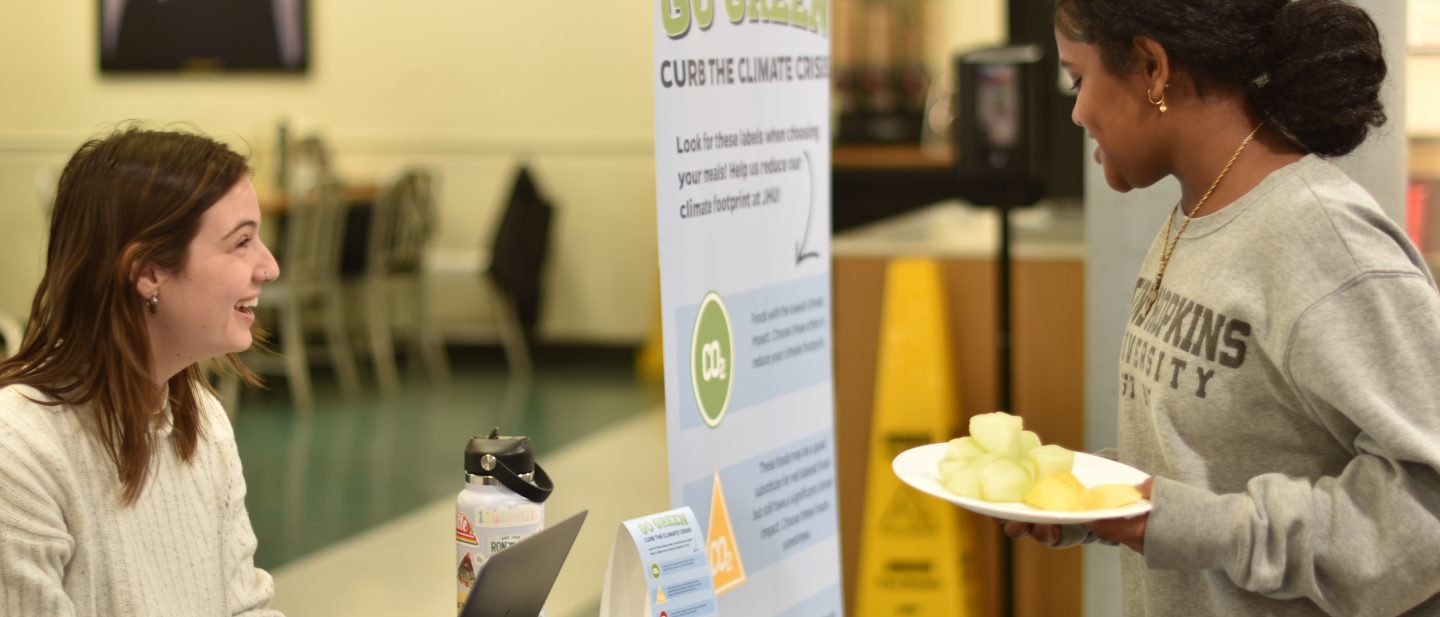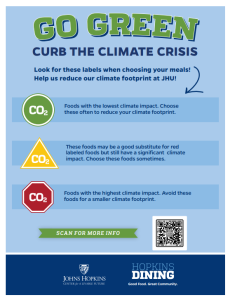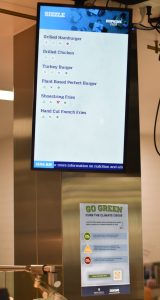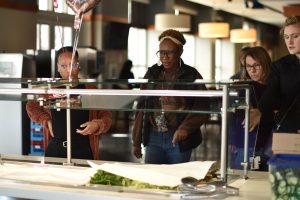
Throughout the past year, Hopkins Dining and the Bloomberg School of Public Health’s Center for a Livable Future (CLF) embarked on a study to explore the influence of climate labels on student food choices. The study aims to empower students with knowledge of how their food choices may contribute to climate change. In partnership with Sustainability Manager for Hopkins Dining, Graham Browning, researchers incorporated climate labels into Hopkins Dining’s digital menus to assess the impact on food selections.
The research team included Professor Julia Wolfson, CLF Program Officers Daphene Altema-Johnson, Becky Ramsing, and Brent Kim, as well as graduate students Elham Ali, Ruby Young, and Carolyn Kowalski.
We spoke with Graham Browning to learn more about these collaborative efforts and their connection to using JHU campuses as a living laboratory to test sustainability solutions.
What has the process for this study looked like so far?

First, a menu was developed to be used for month-long periods in two dining halls — once in the fall without climate labels and again in the spring with climate labels. The labels are meant to encourage students to choose lower climate impact foods — like vegetarian, poultry, or seafood more often and with higher climate impact foods like red meat less often, based on each ingredient’s associated greenhouse gas emissions.
In addition to better understanding student diets and perceptions, the study also sheds light on dining procurement practices, notes Browning. “The results will help us get a baseline of where we are in terms of climate impact with our food purchases.”
Furthermore, she emphasized that the findings will inform menu adjustments and guide educational campaigns to effectively communicate their message, facilitating a meaningful transition towards climate-conscious choices and fostering tangible environmental change.
How has your partnership with the Center for a Livable Future evolved?
“The Center for a Livable Future has such a long and well-established history of food system research that having that as our first kind of experiment with the Campus as a Living Lab was good, because it can help get our foot in the door for more research possibilities,” said Browning.
Founded in 1996, CLF has worked for years to build a healthier, more equitable, and resilient food system and supports shifts toward plant-rich diets as a critical action needed to reduce greenhouse gas emissions from food. Prior to the climate labeling study, Hopkins Dining teamed up with CLF for the Meatless Monday campaign, which encourages climate-friendly menu and dining choices and is still running to this day.
Browning also noted that the Office of Sustainability, the Sustainability Leadership Council, and the Sustainability Symposium have been key to finding opportunities to forge new partnerships and collaborations.

Can you describe one or two main challenges faced during the research and how the team overcame them?
“Streamlining communication between location managers, sous chefs, the food system services team, me, and the researchers was one of the main challenges,” said Browning.
When collaborating with both researchers and operational teams, differing timelines are common. She underscored the extensive nature of their menus, emphasizing the realistic timeframe needed by CLF for thorough assessments of recipes and meticulous calculations to ensure accurate tagging of climate labels for each recipe.
Luckily, the experience gained through this opportunity will allow future collaborations to be more streamlined.
What advice do you have for students and faculty members interested in conducting research using JHU as a Living Lab?
The Campus as a Living Lab program is designed to foster further collaboration between researchers and administrative partners — like those in this study. Graham emphasized ensuring that everyone is aligned and clearly understands the project’s missions and goals.
The research project provided learning experiences for the dining staff — who are purchasing, preparing, and serving thousands of meals daily — as well as the researchers who are at the cutting edge of food systems innovation and discovery. Graham noted, “having candid conversations and breaking down the scientific backing of these research projects for someone who is on the operations side to understand the ‘why’ behind it is really important.”
Graham and the rest of the research team anticipate the lessons learned in this research are scalable and inspire others to create change anywhere food choices are made.
